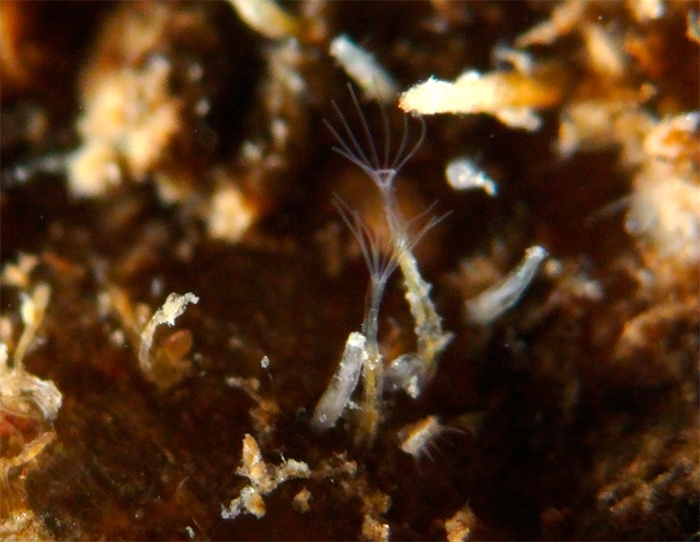

Researchers have identified 12 species of microscopic organisms that encrust rocks and algae in Araçá Bay, between Ilhabela and São Sebastião (zooids of Jebramella angusta n. gen. et sp., which belongs to a new family of bryozoans, the Jebramellidae n. fam. / photo: Cifonauta/USP)
Researchers have identified 12 species of microscopic organisms that encrust rocks and algae in Araçá Bay, between Ilhabela and São Sebastião.
Researchers have identified 12 species of microscopic organisms that encrust rocks and algae in Araçá Bay, between Ilhabela and São Sebastião.

Researchers have identified 12 species of microscopic organisms that encrust rocks and algae in Araçá Bay, between Ilhabela and São Sebastião (zooids of Jebramella angusta n. gen. et sp., which belongs to a new family of bryozoans, the Jebramellidae n. fam. / photo: Cifonauta/USP)
By Elton Alisson
Agência FAPESP – Researchers at the University of São Paulo’s Marine Biology Center, working with colleagues from the Federal University of Pernambuco (UFPE) and the Smithsonian Marine Station in Florida (USA), have discovered 12 species of bryozoans (marine invertebrate animals that encrust substrates such as rocks and algae) in Araçá Bay, located between Ilhabela and São Sebastião, on the coast of São Paulo State.
They have classified one species – Jebramella angusta n. gen. et sp. – as belonging to a new family and genus of bryozoans: Jebramellidae n. fam.
The new organisms were identified under the aegis of FAPESP’s BIOTA Program and a thematic project funded by FAPESP. They were described in an article published by the journal Zootaxa.
“Jebramella angusta n. gen. et sp. was discovered by chance ,” Leandro Manzoni Vieira, a professor at UFPE’s Biological Science Center and first author of the study, told Agência FAPESP.
“We had already observed this new species encrusted on rocks and shell fragments. On filming it, we found that it presents a structure and behavior hitherto unknown in bryozoans,” said Vieira, who carried out postdoctoral studies at Cebimar under the supervision of Professor Alvaro Esteves Migotto with a fellowship from FAPESP.
According to Vieira, bryozoans, commonly known as “sea moss”, form encrusting colonies on rocks, shells and algae with diameters that range from millimeters to 5 centimeters.
Each colony is composed of individuals called zooids, which present an exoskeleton with separate internal compartments, or zoeecia, occupied by organisms called polypides, which are each very small and have tiny tentacles (approximately 0.3-1.2 mm in length).
In known species of bryozoa, such as ctenostomes, embryos are brooded (incubated) internally in zooids.
In the newly discovered bryozoan family, however, the researchers observed that embryos are brooded in an external structure shaped like a hood that is moved by protraction and retraction of the polypides’ tentacles.
The external compartment has an orifice that opens when the tentacle is projected outside and closed by the embryos when the polypides retract it.
“There were no descriptions in the scientific literature of this kind of polypide behavior and external bryozoan brooding structure,” Vieira said. “Although there are other families close to the one we discovered, none of them presents externally brooded embryos.”
Living specimens
According to Vieira, the discovery of 12 new species of bryozoa was possible, among other factors, thanks to the observation of live animals. Species belonging to the Ctenostomata order have traditionally been described on the basis of microscopic observations and analyses of zooids preserved in alcohol.
Studies based on such methodology, however, do not permit a detailed observation of differences in coloring, morphology and behavior, among other characteristics of the species concerned.
“We noticed that there were differences in the results produced by the analysis of living specimens compared with those produced by the analysis of zooids preserved in alcohol,” Vieira said. “Information about a species is mostly lost when it’s preserved in alcohol.”
To perform their analyses of live animals, the researchers collected specimens in areas adjoining or close to Araçá Bay and took them to Cebimar, where they were kept alive in pots of running seawater.
The animals were photographed and filmed using digital cameras mounted on a stereoscopic microscope (a microscope with two eyepieces for binocular vision).
In this way, the researchers were able to observe in detail the coloring, morphology and behavior of the species they had discovered.
“As we were filming the live specimens, we began to see several differences in their behavior, especially with regard to the movement of their tentacles,” Vieira said.
Few studies
Bryozoa of the order Ctenostomata, to which the 12 new species discovered belong, are relatively common in warm shallow marine environments (up to 200 m in depth) and/or estuarine habitats. However, like other orders of bryozoa, they have rarely been studied in Brazil and worldwide.
“There are few studies of bryozoa in general because few researchers specialize in this group of animals,” Vieira explained.
“More studies are needed,” he stressed, “so that we can determine how these animals reproduce, for example. We know practically nothing on that subject.”
The article “Ctenostomatous Bryozoa from São Paulo, Brazil, with descriptions of twelve new species” (doi: 10.11646/zootaxa.3889.4.2), by Vieira et al., can be read in Zootaxa at http://biotaxa.org/Zootaxa/article/view/zootaxa.3889.4.2.
Photographs and videos of the new family of bryozoans are available from Cebimar’s Cifonauta Marine Biology Database and can be viewed online at cifonauta.cebimar.usp.br/taxon/jebramella-angusta/.
Republish
The Agency FAPESP licenses news via Creative Commons (CC-BY-NC-ND) so that they can be republished free of charge and in a simple way by other digital or printed vehicles. Agência FAPESP must be credited as the source of the content being republished and the name of the reporter (if any) must be attributed. Using the HMTL button below allows compliance with these rules, detailed in Digital Republishing Policy FAPESP.





